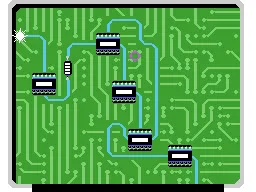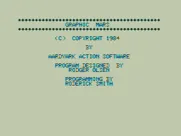2010: The Graphic Action Game
Description
This is a game based on the movie, 2010: The Year We Made Contact.
You are an astronaut aboard the Discovery and need to repair its systems before it crashes into Jupiter's moon, Io. Time is limited so do not dawdle or the Discovery will be destroyed.
You move the reticule over a trouble spot and press the A button to begin repairs. You must then select a path for the power to run so it powers all the components on that circuit board then move on.
If the floating ring touches a component while you are at it or you create a feedback loop, you will damage the component and will need to repair it before you can continue, costing you time.
Sometimes, you will need to return to a circuit to repair a component then restart it.
Groups +
Screenshots
Credits (ColecoVision version)
6 People
| Game Design: | |
| Computer Graphics: | |
| Audio Design: | |
| Documentation: |
|
Reviews
Critics
Average score: 25% (based on 1 ratings)
Players
Average score: 2.9 out of 5 (based on 6 ratings with 1 reviews)
Fun action puzzle game for the Colecovision
The Good
2010: The Graphic Action Game for the ColecoVision came out alongside 2010: The Text Adventure Game for the Coleco Adam. The movie 2010 had just come out the year before to some success, so I suppose Coleco was trying to capitalise on its popularity. In the action game, you must repair the Discovery before its orbit deteriorates too much and it crashes into the moon Io below it. There are also volcanic torrents that shoot up from the planet which can sometimes damage sections of the ship you've already repaired.
The sections of the ship you need to repair are circuits that you must direct a spark through the pathways from the start to the finish, making sure to pass through each component chip along the way exactly once, and not passing back along the same path. If you pass through a chip more than once, it will blow the chip and you'll have to waste time replacing it. There's also another spark floating around the circuit, and if it passes through a chip that your spark is already in, it will also blow the chip. There are more channels than you need, and they're very twisty, making it necessary for you to be careful which path you take from a given chip, or you may cycle back to a chip you've already energised and blow it, or skip a chip and will have to de-energise backwards to take a different path.
There is another type of circuit as well, for repairing the HAL 9000 unit on the ship. These circuits are quite different. You can't slow down or reverse your spark, and you don't want to energize any chips (there are usually at least 2 or so in a HAL circuit). The main point is to navigate through several nodes, which can be set to either let the spark pass straight through, turn clockwise 90 degrees, or reflect 180 degrees back the way it came. You can only change what the node is set to when it's the next node the spark is about to reach, so it's verry frantic.
Once enough HAL circuits are repaired, HAL can help you by repairing one circuit while you repair another. HAL is much slower than you, can't replace any damaged chips, and can't repair HAL circuits (for obvious reasons). I'm not sure how many HAL circuits need to be repaired for HAL to be able to repair other circuits, but he can try if even a single HAL circuit is functional. I don't know if it just makes him take longer, or if he's more likely to damage a chip if there are broken HAL circuits. I haven't been able to get good enough at fixing the HAL circuits to figure that out.
The circuits are classified as Engine, Reactor, Life Support, Communication, or HAL, and you have monitors on the bottom half of the screen when looking at the ship overview map that let you know their overall state. Once you have the Engine and Reactor circuits repaired, you can attempt a jump start by starting the engines for a short burn, and then shut them off. This can give you a slight altitude boost, but if you leave them on for too long, all the engine and reactor circuits burn out without boosting your altitude at all, creating even more problems. I haven't been able to pull this manoeuvre off successfully yet.
At the beginning of the game, you can select your difficulty from 1 to 4. At difficulty 1 you start at the highest altitude, and all the HAL circuits are already functional (and don't break), so HAL can help repair circuits right from the start. Difficulty 2 starts you at a slightly lower altitude, and the HAL circuits begin broken. Difficulties 3 and 4 are the same as difficulty 2, except at progressively lower starting altitudes. The percentage of circuits that must be fixed before you're able to take off increases with the higher difficulties as well.
Once you've repaired enough circuits of each category, if you start the engines, the ship will fully power on and escape orbit, winning the game, but if you're not quick enough, the ship will gradually sink towards Io, making it more likely to take damage from eruptions from the surface, and eventually you'll crash and get a game over. The losing sequence is more entertaining than the winning sequence because you see the system monitor shut down and hear a bunch of random sounding noises, while the winning sequence shows the ship on the monitor moving forward to the right, until it scrolls off the display.
I have only been able to beat the game at difficulty level 1.
I found the game at that level to be a little too easy, but still quite fun. The graphics are absolutely phenomenal for a second-generation console like the ColecoVision. The only music is the familiar opening phrase of the 2001 overture, played once when the difficulty selection is shown. There are some sound effects during the game for the volcanic eruptions, as well as while repairing circuits, so it gets good marks for sound as well. The story follows the same idea as the film, so high marks for story as well. Everything makes sense from that perspective, and you can really feel like you're racing against time to fix this untrustworthy AI to help repair the ship enough to go back to Earth.
The Bad
There are no other characters, though. Not even in the manual, other than Commissioner Thomas Charles, who supposedly wrote your mission instructions. But no mention of the Russians that were supposed to be flying you out to the Discovery, or the other American crew that were supposed to be helping repair HAL and the ship.
Technically, you're not even going out to the ship, and this is all just a simulation to prepare you to leave on the actual mission, and that just feels like a missed opportunity to me.
Also, the HAL circuits are extremely difficult to figure out, and end up taking way too long to fix, to the point it might be easier for a player to just focus on fixing the other circuits first before even trying to fix the HAL circuits so you can use the rocket boost a bunch of times, if you can figure out the timing for that.
But otherwise, I think it's a pretty solid game for the era.
The Bottom Line
Overall, 2010: The Graphic Action Game is a fun action puzzle game with exceptionally good graphics and sound for the time, but it gets significantly harder at anything other than easiest difficulty level. If I had an actual ColecoVision, I would try to get a copy of this game. I do think it would be worth the effort to get good at it.
ColecoVision · by NixieLake (28) · 2022
Discussion
| Subject | By | Date |
|---|---|---|
| Re: Michael A. Stackpole's lost classic? | Terok Nor (45222) | Dec 17, 2014 |
| Michael A. Stackpole's lost classic? | Pseudo_Intellectual (67780) | Feb 6, 2008 |
Analytics
Identifiers +
Contribute
Are you familiar with this game? Help document and preserve this entry in video game history! If your contribution is approved, you will earn points and be credited as a contributor.
Contributors to this Entry
Game added by LepricahnsGold.
Game added June 1, 2006. Last modified December 4, 2023.














